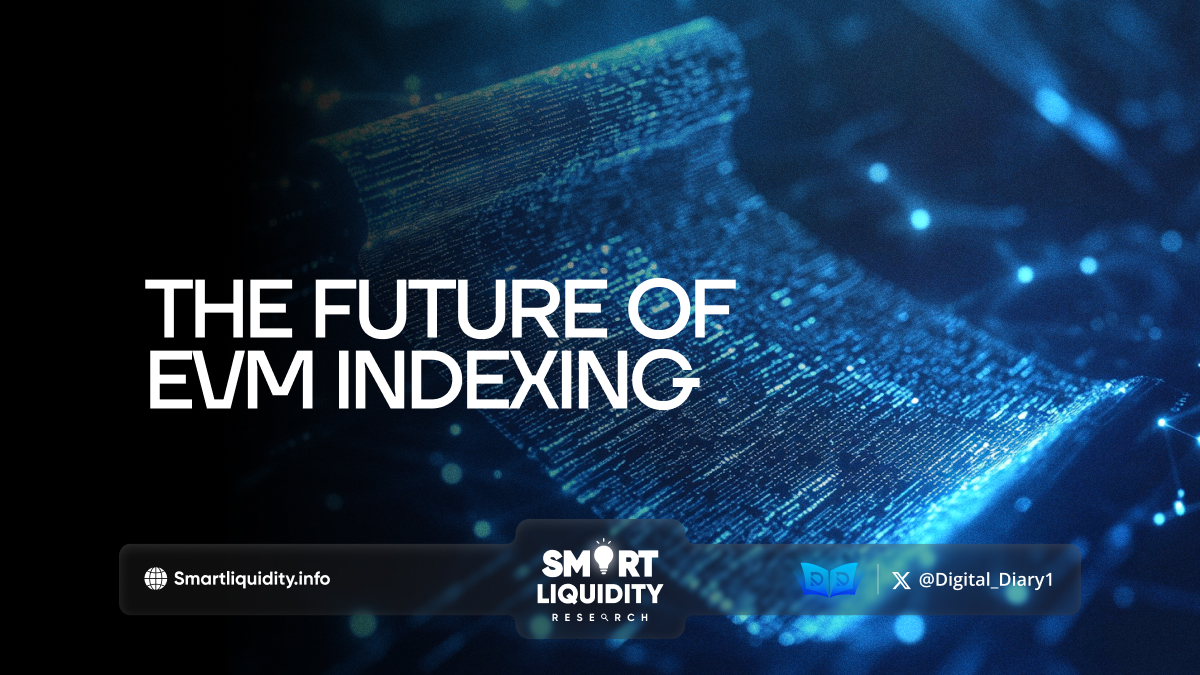THE FUTURE OF EVM INDEXING


Blockchain has revolutionized countless industries, but the engine powering most decentralized applications (dApps) on Ethereum and other chains, the Ethereum Virtual Machine (EVM), is the real game-changer. EVM indexing is evolving from a backend necessity to a key enabler of real-time, cross-chain data, becoming a fundamental pillar of Web3.
What is EVM Indexing, and Why Does it Matter?
EVM indexing organizes and retrieves Ethereum (or EVM-compatible) blockchain data, enabling quick access to relevant information for developers, users, and analytics platforms.
From smart contract events to token balances and transfers, indexed data is at the heart of user-facing blockchain applications. As dApp demand rises and cross-chain solutions grow, EVM indexing is evolving to handle more data and ensure interoperability.
Current Challenges in EVM Indexing
Even though it’s essential, EVM indexing is no walk in the park. Traditional indexing methods face several challenges:
- Scalability: The rapid expansion of blockchain ecosystems means exponential growth in data. For every new dApp, NFT, or DeFi protocol, there’s a corresponding influx of data that requires indexing.
- Decentralization Trade-offs: Many indexing solutions still rely on centralized components to optimize speed and efficiency, but this centralization conflicts with the decentralized ethos of blockchain.
- Cross-chain Complexity: With the emergence of cross-chain projects, data must be synchronized and indexed across multiple blockchains. Achieving this without sacrificing speed or accuracy is a complex task.
- Real-time Data Needs: Traditional indexing setups often struggle to keep up with real-time demands. For DeFi protocols, gaming applications, and other high-frequency use cases, delays in data retrieval can lead to missed opportunities or even financial losses.
Overcoming these challenges is essential for the next evolution of blockchain applications, and the future of EVM indexing is all about resolving them with innovative solutions.
Key Innovations Shaping the Future of EVM Indexing
To address the challenges above, developers and blockchain researchers are working on new indexing solutions that promise to reshape how we access and interact with on-chain data. Here are some of the most exciting advancements:
- Decentralized Indexing Protocols: Decentralized indexing protocols like The Graph and Subquery enable developers to create and share subgraphs, allowing Dapp’s to efficiently retrieve blockchain data while maintaining decentralization.
- Layer 2 Indexing: Layer 2 solutions have revolutionized scalability, and now they’re being extended to indexing. Using layer 2 infrastructure allows indexing processes to be performed faster and more efficiently, helping to reduce congestion on the main chain and accelerate data retrieval for Dapp’s, especially those with high data volumes.
- Cross-chain Indexing Frameworks: With Web3 becoming more interoperable, cross-chain indexing solutions are gaining momentum. Protocols that unify data from EVM and non-EVM chains will give developers broader datasets, enabling multi-chain dApps with a unified experience.
- AI and Machine Learning for Data Optimization: Implementing AI in EVM indexing could revolutionize the data-querying process. Machine learning algorithms can analyze data retrieval patterns, predict queries, and pre-cache commonly accessed data, reducing latency and increasing efficiency. AI can also help anticipate network congestion and optimize indexing parameters on the fly, creating a smoother experience for users.
- Real-Time Indexing Capabilities: Solutions that facilitate near-instant indexing of blockchain data will be invaluable for sectors that require high responsiveness, like DeFi and gaming. Real-time indexing would eliminate the delay between when a transaction occurs and when it’s accessible by applications, allowing for immediate reactions to on-chain events.
- Privacy-Preserving Indexing: With regulatory scrutiny on the rise and data privacy concerns growing, privacy-preserving indexing is becoming increasingly relevant. Future indexing solutions could use zk-SNARKs to enable private data retrieval, transforming industries like finance and healthcare adopting blockchain.
The Impact of Advanced EVM Indexing on Blockchain and Beyond
With advanced EVM indexing, the way we use and build blockchain applications will undergo a significant transformation. Here’s how improved indexing will impact both the Web3 space and other industries:
- Enhanced User Experience: Faster and more reliable data access means smoother interactions on Dapp’s, bridging the gap between Web2 and Web3 UX expectations.
- Greater Interoperability: Cross-chain indexing will enable Dapp’s that operate seamlessly across multiple blockchains, driving forward the idea of an interconnected blockchain ecosystem.
- Increased Developer Efficiency: Improved indexing tools allow developers to build more complex applications with greater ease, as they can access the necessary data without writing custom indexing solutions.
- Broader Enterprise Adoption: With privacy-preserving indexing, enterprises in regulated sectors can leverage blockchain without compromising user privacy or regulatory compliance. This development could open the door to wider blockchain adoption in industries like finance, healthcare, and real estate.
- New Revenue Streams for Data Providers: Advanced indexing solutions enable decentralized data markets, letting providers monetize data schemas and algorithms for developers and cur
EVM indexing is shifting from a backend tool to a key driver of a connected, efficient, and truly decentralized blockchain.
The future of EVM indexing is bright and filled with possibilities. As blockchain technology becomes increasingly central to finance, supply chains, gaming, and beyond, the demand for optimized data access will only grow. Enhanced indexing solutions are poised to be the cornerstone of this evolution, making blockchain data more accessible, interoperable, and user-friendly.
EVM indexing will soon advance from backend utility to a key enabler of a connected, efficient, and user-focused blockchain, driving the industry toward true decentralization




